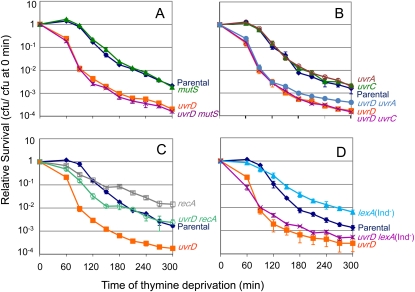Figure 1 .
RecA contributes SOS independently to the hyper-TLD of ΔuvrD cells, but neither NER nor MMR intermediates do. (A) Mismatch-repair intermediates are not the main cause of hyper-TLD of ∆uvrD cells. First, mismatch-repair-defective ΔmutS (SMR10445; solid green triangle) cells are not significantly different from the parental strain (AB2497; solid blue diamond). Second, a ΔuvrD ΔmutS double mutant (SMR11206; purple X) showed the same hypersensitivity to TLD as ΔuvrD (SMR11194; solid orange square) alone, indicating that the accumulation of MMR intermediates created by MutS did not cause most hyper-TLD of ΔuvrD cells. (B) NER intermediates are not the main cause of the hyper-TLD of ∆uvrD cells. NER-defective ΔuvrA (SMR13005; open red circle) and ΔuvrC (SMR11207; solid green triangle) cells are not significantly different from the parental strain (AB2497; solid blue diamond). Neither a ΔuvrD ΔuvrA double mutant (SMR13007; solid blue circle), nor a ΔuvrD ΔuvrC double mutant (SMR12996; purple X) showed less hypersensitivity to TLD than ΔuvrD cells (SMR11194; solid orange square) indicating that UvrABC-generated NER intermediates are not the main cause of the ∆uvrD hyper-TLD. (C) RecA is partially required for the hypersensitivity to TLD of ΔuvrD cells. A ΔuvrD ΔrecA double mutant (SMR11199; open green circle) was not as resistant to TLD as the ΔrecA single mutant (SMR10433; open gray square; P < 0.05), but was significantly more resistant than the ΔuvrD single mutant (SMR11193; solid orange square; P < 0.05). Parental: AB2497; solid blue diamond. (D) The SOS response is not required for the hyper-TLD of ΔuvrD cells. The SOS-blocking lexA(Ind−) allele did not relieve the hypersensitivity of ΔuvrD cells. Strains used from top to bottom: lexA(Ind−) (SMR11314; solid blue triangle), parental (AB2497; solid blue diamond), ΔuvrD lexA(Ind−) (SMR11317; purple X), ΔuvrD (SMR11193; solid orange square). Means ±SEM of three independent experiments.

